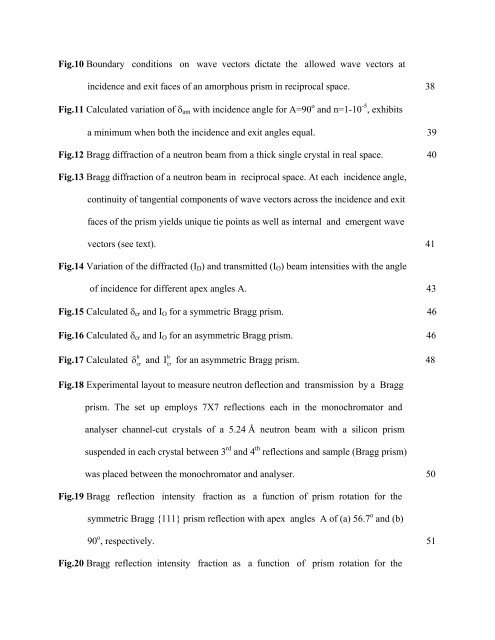PHYS01200804001 Sohrab Abbas - Homi Bhabha National Institute
PHYS01200804001 Sohrab Abbas - Homi Bhabha National Institute
PHYS01200804001 Sohrab Abbas - Homi Bhabha National Institute
Create successful ePaper yourself
Turn your PDF publications into a flip-book with our unique Google optimized e-Paper software.
Fig.10 Boundary conditions on wave vectors dictate the allowed wave vectors at<br />
incidence and exit faces of an amorphous prism in reciprocal space. 38<br />
Fig.11 Calculated variation of δ am with incidence angle for A=90 o and n=1-10 -5 , exhibits<br />
a minimum when both the incidence and exit angles equal. 39<br />
Fig.12 Bragg diffraction of a neutron beam from a thick single crystal in real space. 40<br />
Fig.13 Bragg diffraction of a neutron beam in reciprocal space. At each incidence angle,<br />
continuity of tangential components of wave vectors across the incidence and exit<br />
faces of the prism yields unique tie points as well as internal and emergent wave<br />
vectors (see text). 41<br />
Fig.14 Variation of the diffracted (I D ) and transmitted (I O ) beam intensities with the angle<br />
of incidence for different apex angles A. 43<br />
Fig.15 Calculated δ cr and I O for a symmetric Bragg prism. 46<br />
Fig.16 Calculated δ cr and I O for an asymmetric Bragg prism. 46<br />
Fig.17 Calculated<br />
b<br />
δ<br />
cr<br />
and<br />
b<br />
I<br />
cr<br />
for an asymmetric Bragg prism. 48<br />
Fig.18 Experimental layout to measure neutron deflection and transmission by a Bragg<br />
prism. The set up employs 7X7 reflections each in the monochromator and<br />
analyser channel-cut crystals of a 5.24 Å neutron beam with a silicon prism<br />
suspended in each crystal between 3 rd and 4 th reflections and sample (Bragg prism)<br />
was placed between the monochromator and analyser. 50<br />
Fig.19 Bragg reflection intensity fraction as a function of prism rotation for the<br />
symmetric Bragg {111} prism reflection with apex angles A of (a) 56.7 o and (b)<br />
90 o , respectively. 51<br />
Fig.20 Bragg reflection intensity fraction as a function of prism rotation for the
















